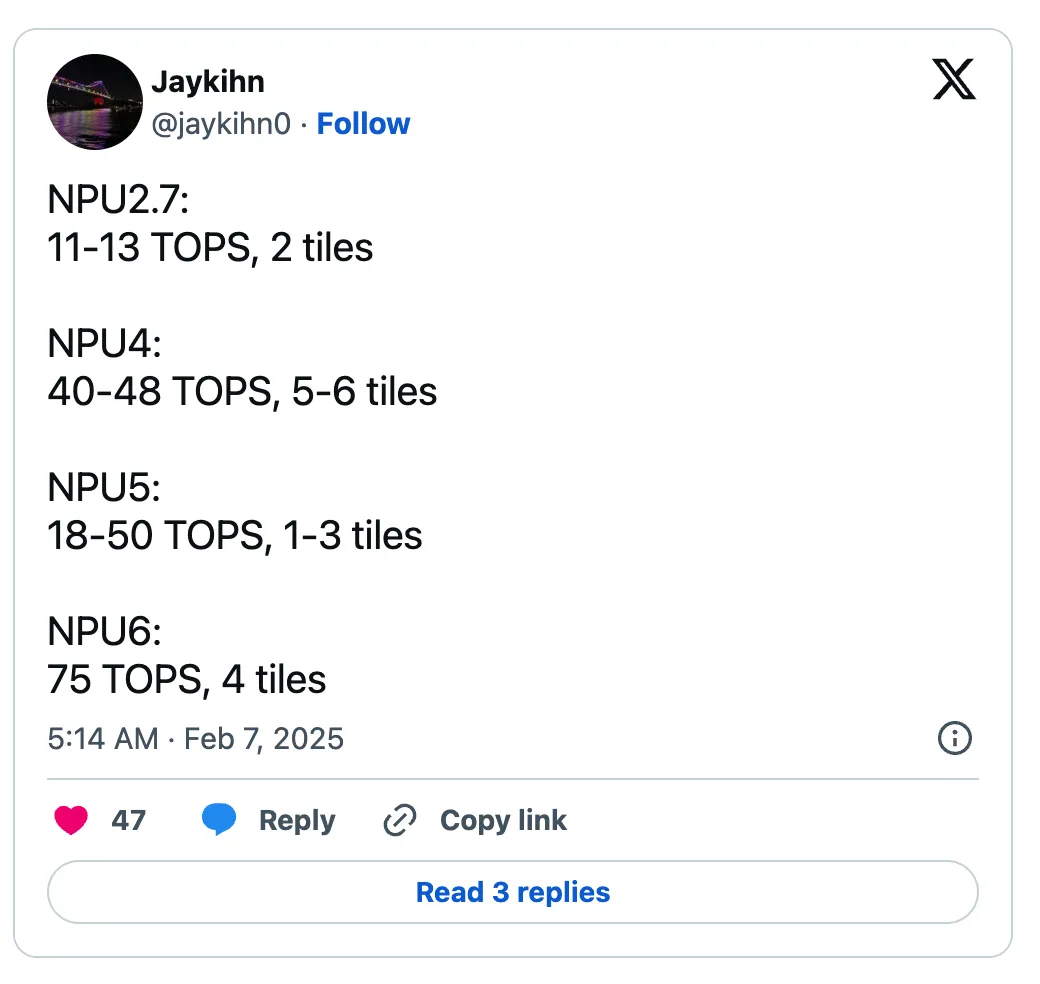Intel originally planned to launch an updated version of its Arrow Lake-S desktop CPU series, dubbed the “Arrow Lake-S Refresh,” featuring minor upgrades to the original design to boost competitiveness. This new product shares the same design framework as the Arrow Lake-HX mobile chip. According to industry insiders, this plan was previously shelved for undisclosed reasons but has now been revived, with an expected release in the second half of 2025 to meet consumers.
The Arrow Lake-S Refresh belongs to Intel’s Core Ultra Series 3 product line, with a key highlight being an upgraded Neural Processing Unit (NPU). Compared to the current Core Ultra Series 2 “Arrow Lake” chips, which offer 13 TOPS (trillion operations per second) of AI performance, the new chip will adopt a more advanced NPU architecture, further enhancing AI capabilities. Intel has been steadily advancing its NPU technology in recent years, progressing from the early NPU1 (0.5 TOPS) to the NPU4 in Lunar Lake (48 TOPS), achieving significant leaps in computational power. It’s reported that the Arrow Lake-S Refresh will integrate the NPU5 architecture, expected to deliver 18-50 TOPS of AI performance in a 1-3 tile configuration, providing stronger support for AI-driven applications like Copilot+. Looking ahead, Intel’s roadmap indicates that the next-generation NPU6 will debut in chips like Nova Lake, with performance potentially reaching 75 TOPS.
This update will also continue support for the existing LGA 1851 platform, a socket design first introduced with Arrow Lake-S in 2024 and planned to remain in use at least until 2026. While the exact release date is yet to be finalized, given that Nova Lake is slated for 2026, the Arrow Lake-S Refresh is likely to fill a product gap in the second half of 2025. Notably, the new chip is expected to bring improvements in gaming optimization. The current Core Ultra 200S series has shown underwhelming gaming performance, with some tests indicating it lags approximately 2% behind the previous-generation Core i9-14900K and around 10% behind AMD’s Ryzen 7 7800X3D. Intel clearly aims to reverse this trend with the refresh, enhancing the experience for gamers.
Meanwhile, Intel is accelerating its mobile segment strategy. The Arrow Lake-HX series will also receive an update, targeting high-performance mobile devices, while Panther Lake is aimed at the gaming handheld market. This mobile-oriented chip will also feature the NPU5 architecture, with top-tier models expected to include 4 performance cores (P-cores), 8 efficiency cores (E-cores), and 4 low-power cores (LPE-cores), paired with a 12 Xe3 integrated GPU based on the Celestial architecture. Supporting LPDDR5X memory, the total platform performance could reach 180 TOPS, with the NPU contributing 50 TOPS and the GPU providing 120 TOPS. This configuration makes it highly promising for thin-and-light laptops and portable devices.
Specific upgrade details for the Arrow Lake-S Refresh remain limited, but industry speculation suggests its core configuration may stay consistent with existing models, such as the 24-core (8P+16E) layout, with the primary changes focused on the NPU module. According to leaks, the SoC die size will increase by approximately 2.8 mm due to the NPU upgrade, though the overall package size will remain unchanged to ensure compatibility with existing LGA 1851 motherboards. However, motherboard manufacturers may need to adjust the VccSA power rail design to support Fast Voltage Mode (FVM) to fully unlock the new chip’s performance.

Looking to the future, Intel’s CPU roadmap is fairly clear. Following the Arrow Lake-S Refresh, Panther Lake will target the mobile market, while Nova Lake is positioned as the next-generation desktop flagship. Rumors suggest Nova Lake could feature up to 52 cores (16P+32E+4LPE), a cache size of 144MB, and an IPC (instructions per clock) improvement of over 60% compared to Raptor Lake, with a planned debut in the second half of 2026. This positions the Arrow Lake-S Refresh as not just a transitional product but also a stepping stone for future technological iterations.
For tech enthusiasts, the Arrow Lake-S Refresh stands out for its enhanced AI performance and potential gaming optimizations. While not a revolutionary upgrade, its timing aligns with the explosive growth of AI applications, potentially delivering a smarter, more efficient experience for desktop users. Whether this chip can deliver on its promises in the second half of 2025 remains to be seen—stay tuned.
